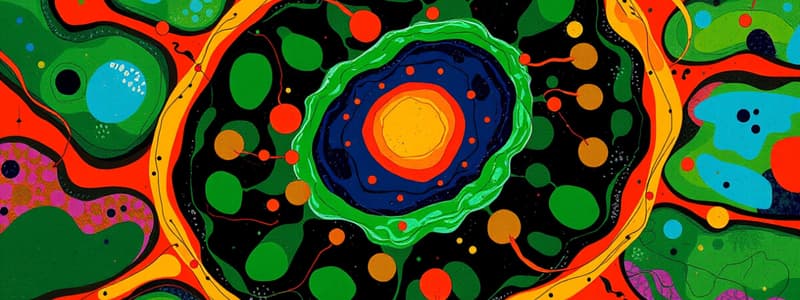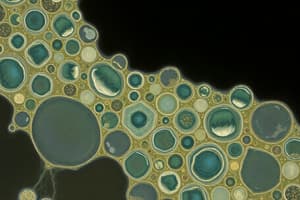Podcast
Questions and Answers
การขนส่งชนิดใดที่ต้องใช้พลังงานเพื่อเคลื่อนที่สารที่มีความเข้มข้นสูงขึ้น?
การขนส่งชนิดใดที่ต้องใช้พลังงานเพื่อเคลื่อนที่สารที่มีความเข้มข้นสูงขึ้น?
- การเข้าห้อง
- การขนส่งเชิงรุก (correct)
- การแพร่กระจาย
- การออกห้อง
กระบวนการใดที่เซลล์ใช้ในการย่อยสลายและกินสารต่างๆ?
กระบวนการใดที่เซลล์ใช้ในการย่อยสลายและกินสารต่างๆ?
- การออกห้อง
- การขนส่งเชิงรุก
- การแพร่กระจาย
- การฟาโกไซโทซิส (correct)
โมเลกุลใดที่ทำหน้าที่เป็นผู้ส่งสัญญาณภายในเซลล์?
โมเลกุลใดที่ทำหน้าที่เป็นผู้ส่งสัญญาณภายในเซลล์?
- สัญญาณที่สอง (correct)
- โมเลกุลที่ใช้พลังงาน
- รีเซ็ปเตอร์
- เซลล์ประกอบ
กลไกการตรวจสอบใดที่มีความสำคัญในการป้องกันการพัฒนาของมะเร็ง?
กลไกการตรวจสอบใดที่มีความสำคัญในการป้องกันการพัฒนาของมะเร็ง?
กระบวนการใดที่เซลล์ใช้เพื่อปล่อยสารออกสู่ภายนอก?
กระบวนการใดที่เซลล์ใช้เพื่อปล่อยสารออกสู่ภายนอก?
เซลล์ประเภทใดที่ไม่มีนิวเคลียสและออร์แกเนลล์ที่มีเยื่อหุ้ม?
เซลล์ประเภทใดที่ไม่มีนิวเคลียสและออร์แกเนลล์ที่มีเยื่อหุ้ม?
อะไรมักจะทำหน้าที่เป็น 'โรงงานผลิตพลังงาน' ของเซลล์?
อะไรมักจะทำหน้าที่เป็น 'โรงงานผลิตพลังงาน' ของเซลล์?
การแบ่งเซลล์แบบใดที่ส่งผลให้เกิดเซลล์ลูกสาวที่มีลักษณะทางพันธุกรรมเหมือนกัน?
การแบ่งเซลล์แบบใดที่ส่งผลให้เกิดเซลล์ลูกสาวที่มีลักษณะทางพันธุกรรมเหมือนกัน?
กลไกใดที่ทำให้โมเลกุลเคลื่อนที่ผ่านเยื่อหุ้มเซลล์โดยไม่ต้องใช้พลังงาน?
กลไกใดที่ทำให้โมเลกุลเคลื่อนที่ผ่านเยื่อหุ้มเซลล์โดยไม่ต้องใช้พลังงาน?
ออร์แกเนลล์ใดที่มีหน้าที่ในการสังเคราะห์โปรตีน?
ออร์แกเนลล์ใดที่มีหน้าที่ในการสังเคราะห์โปรตีน?
กระบวนการใดในการแปลงพลังงานแสงเป็นพลังงานเคมีในพืช?
กระบวนการใดในการแปลงพลังงานแสงเป็นพลังงานเคมีในพืช?
ฟังก์ชันหลักของโกลจิอุปกรณ์คืออะไร?
ฟังก์ชันหลักของโกลจิอุปกรณ์คืออะไร?
แหล่งที่มีอยู่ภายในเซลล์ของพืชที่มีหน้าที่ในการสังเคราะห์ด้วยแสงคืออะไร?
แหล่งที่มีอยู่ภายในเซลล์ของพืชที่มีหน้าที่ในการสังเคราะห์ด้วยแสงคืออะไร?
Flashcards are hidden until you start studying
Study Notes
Cell Biology
Basic Concepts
-
Cell Theory:
- All living organisms are composed of cells.
- The cell is the basic unit of life.
- All cells arise from pre-existing cells.
-
Types of Cells:
- Prokaryotic:
- Lack a nucleus and membrane-bound organelles.
- Example: Bacteria and Archaea.
- Eukaryotic:
- Have a nucleus and membrane-bound organelles.
- Examples: Plant cells, animal cells, fungi, and protists.
- Prokaryotic:
Cell Structure
-
Cell Membrane:
- Composed of a phospholipid bilayer with embedded proteins.
- Functions: protection, communication, and transport.
-
Nucleus:
- Contains genetic material (DNA).
- Site of RNA synthesis.
-
Organelles:
- Mitochondria: Powerhouse of the cell; site of ATP production.
- Ribosomes: Protein synthesis; can be free in cytoplasm or attached to the endoplasmic reticulum.
- Endoplasmic Reticulum (ER):
- Rough ER: Studded with ribosomes; involved in protein synthesis and modification.
- Smooth ER: No ribosomes; involved in lipid synthesis and detoxification.
- Golgi Apparatus: Modifies, sorts, and packages proteins and lipids for secretion.
- Lysosomes: Contain digestive enzymes; break down waste materials.
- Chloroplasts (in plant cells): Site of photosynthesis.
Cellular Processes
-
Cell Division:
- Mitosis: Process of somatic cell division resulting in two identical daughter cells.
- Meiosis: Process of gamete formation resulting in four genetically diverse cells.
-
Cellular Respiration:
- Process of converting glucose into ATP.
- Stages: Glycolysis, Krebs cycle, and Electron Transport Chain.
-
Photosynthesis (in plants):
- Process of converting light energy into chemical energy (glucose).
- Occurs in chloroplasts and involves two main stages: Light-dependent reactions and the Calvin cycle.
Transport Mechanisms
- Passive Transport: Movement of molecules across the cell membrane without energy input (e.g., diffusion, osmosis).
- Active Transport: Movement of molecules against their concentration gradient, requiring energy (e.g., sodium-potassium pump).
- Endocytosis: Process of cell engulfing substances (e.g., phagocytosis, pinocytosis).
- Exocytosis: Process of vesicles fusing with the membrane to release contents outside the cell.
Cellular Communication
- Signal Transduction: Process by which cells respond to external signals.
- Receptors: Proteins on the cell surface that bind to signaling molecules.
- Second Messengers: Molecules that relay signals from receptors to target molecules within the cell.
Cell Cycle Regulation
- Checkpoint Mechanisms: Ensure proper cell division; critical for preventing cancer development.
- Apoptosis: Programmed cell death; eliminates damaged or unnecessary cells.
แนวคิดพื้นฐานเกี่ยวกับเซลล์
- ทฤษฎีเซลล์:
- สิ่งมีชีวิตทุกชนิดประกอบด้วยเซลล์
- เซลล์เป็นหน่วยพื้นฐานของชีวิต
- เซลล์ทั้งหมดเกิดจากเซลล์ที่มีอยู่ก่อนหน้า
- ประเภทของเซลล์:
- โปรคาริโอเต:
- ไม่มีนิวเคลียสและออร์แกเนลล์ที่มีเยื้อหุ้ม
- ตัวอย่าง: แบคทีเรียและอาร์เคีย
- ยูคาริโอเต:
- มีนิวเคลียสและออร์แกเนลล์ที่มีเยื้อหุ้ม
- ตัวอย่าง: เซลล์พืช, เซลล์สัตว์, เชื้อรา, และโปรติสต์
- โปรคาริโอเต:
โครงสร้างเซลล์
- เยื่อหุ้มเซลล์:
- ประกอบด้วยฟอสโฟลิปิดสองชั้นที่มีโปรตีนฝังอยู่
- หน้าที่: การป้องกัน, การสื่อสาร, และการขนส่ง
- นิวเคลียส:
- contains genetic material (DNA)
- เป็นที่ที่เกิดการสังเคราะห์ RNA
- ออร์แกเนลล์:
- ไมโทคอนเดรีย: แหล่งพลังงานของเซลล์; เป็นที่ผลิต ATP
- ไรโบโซม: สังเคราะห์โปรตีน; อาจอยู่ในไซโตพลาสมหรือยึดติดกับเอนโดพลาสมิกเรติคูลัม
- เอนโดพลาสมิกเรติคูลัม (ER):
- Rough ER: มีไรโบโซม; เกี่ยวข้องกับการสังเคราะห์และปรับปรุงโปรตีน
- Smooth ER: ไม่มีไรโบโซม; เกี่ยวข้องกับการสังเคราะห์ไขมันและการดีทอกซ์
- โกลจิอพาราตัส: ปรับปรุง, คัดแยก, และบรรจุโปรตีนและไขมันสำหรับการปล่อย
- ไลโซโซม: มีเอนไซม์ย่อยอาหาร; สลายวัสดุที่ไร้ประโยชน์
- คลอโรพลาสต์ (ในเซลล์พืช): เป็นที่เกิดปฏิกิริยาแฟตโตซินที่ใช้แสง
กระบวนการเซลล์
- การแบ่งเซลล์:
- ไมโทซิส: กระบวนการแบ่งเซลล์แบบ somatic ที่ทำให้เกิดเซลล์ลูกที่เหมือนกันสองเซลล์
- ไมโอซิส: กระบวนการสร้างเซลล์สืบพันธุ์ที่ทำให้เกิดเซลล์ที่มีความหลากหลายทางพันธุกรรมสี่เซลล์
- การหายใจของเซลล์:
- กระบวนการเปลี่ยนกลูโคสเป็น ATP
- ขั้นตอน: ไกลโคลิซิส, วงจรเครบส์, และโซ่การขนส่งอิเล็กตรอน
- การสังเคราะห์ด้วยแสง (ในพืช):
- กระบวนการเปลี่ยนพลังงานจากแสงเป็นพลังงานเคมี (กลูโคส)
- เกิดขึ้นในคลอโรพลาสต์และประกอบด้วยสองขั้นตอนหลัก: ปฏิกิริยาแสงที่ขึ้นกับแสงและวงจรคาลวิน
กลไกการขนส่ง
- การขนส่งแบบผ่อนคลาย: การเคลื่อนที่ของโมเลกุลผ่านเยื่อหุ้มเซลล์โดยไม่ต้องใช้พลังงาน (เช่น การแพร่กระจาย, ออสโมซิส)
- การขนส่งแบบมีพลัง: การเคลื่อนที่ของโมเลกุลข้ามความเข้มข้นที่สูงขึ้น จำเป็นต้องใช้พลังงาน (เช่น ปั๊มนาโตรเลียม-โพแทสเซียม)
- เอนโดไซโทซิส: กระบวนการที่เซลล์กลืนสิ่งของ (เช่น ฟาโกไซโทซิส, พิโนไซโทซิส)
- เอกโซไซโทซิส: กระบวนการที่เวสิเคิลรวมเข้ากับเยื่อหุ้มเพื่อปล่อยเนื้อหานอกเซลล์
การสื่อสารของเซลล์
- การส่งผ่านสัญญาณ: กระบวนการที่เซลล์ตอบสนองต่อสัญญาณจากภายนอก
- ตัวรับ: โปรตีนบนพื้นผิวเซลล์ที่จับกับโมเลกุลสัญญาณ
- สารทุติยภูมิ: โมเลกุลที่ส่งสัญญาณจากตัวรับไปยังโมเลกุลที่เป็นเป้าหมายภายในเซลล์
การควบคุมวัฏจักรเซลล์
- กลไกการตรวจสอบ: มั่นใจว่าการแบ่งเซลล์เป็นไปอย่างถูกต้อง; สำคัญในการป้องกันการพัฒนามะเร็ง
- อัปโปโทซิส: การตายเซลล์ที่ถูกกำหนด; กำจัดเซลล์ที่มีความเสียหายหรือต้องการน้อย
Studying That Suits You
Use AI to generate personalized quizzes and flashcards to suit your learning preferences.




